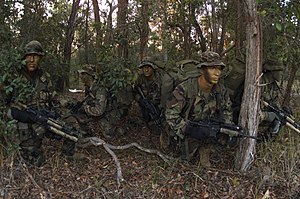
Back تسلل حربي Arabic Infiltration (Militär) German فنون نفوذ Persian Hutier-taktiikka Finnish Ynfiltraasje (militêr) Frisian 浸透戦術 Japanese Infiltrasjonstaktikk NB Przenikanie Polish Infiltração (militar) Portuguese Инфильтрация (тактика) Russian

| Part of a series on |
| War |
|---|
 |
In warfare, infiltration tactics involve small independent light infantry forces advancing into enemy rear areas, bypassing enemy frontline strongpoints, possibly isolating them for attack by follow-up troops with heavier weapons. Soldiers take the initiative to identify enemy weak points and choose their own routes, targets, moments and methods of attack; this requires a high degree of skill and training, and can be supplemented by special equipment and weaponry to give them more local combat options.
Forms of these infantry tactics were used by skirmishers and irregulars dating back to classical antiquity, but only as a defensive or secondary tactic; decisive battlefield victories were achieved by shock combat tactics with heavy infantry or heavy cavalry, typically charging en masse against the primary force of the opponent. By the time of early modern warfare, defensive firepower made this tactic increasingly costly. When trench warfare developed to its height in World War I, most such attacks were complete failures. Raiding by small groups of experienced soldiers, using stealth and cover was commonly employed and often successful, but these could not achieve decisive victory.
Infiltration tactics developed slowly through World War I and early World War II, partially as a way of turning these harassing tactics into a decisive offensive doctrine. At first, only special units were trained in these tactics, typified by German Stoßtruppen (storm troops). By the end of World War II, almost all regular ground forces of the major powers were trained and equipped to employ forms of infiltration tactics, though some specialize in this, such as commandos, long-range reconnaissance patrols, US Army Rangers, airborne and other special forces, and forces employing irregular warfare.[1]
While a specialist tactic during World War I, infiltration tactics are now regularly fully integrated as standard part of the modern maneuver warfare, down to basic fire and movement at the squad and section level, so the term has little distinct meaning today. Infiltration tactics may not be standard in modern combat where training is limited, such as for militia or rushed conscript units, or in desperate attacks where an immediate victory is required. Examples are German Volkssturm formations at the end of World War II, and Japanese banzai attacks of the same period.
- ^ The Handbook Of The SAS And Elite Forces. How The Professionals Fight And Win. Edited by Jon E. Lewis. p.287-Tactics And Techniques, Landings And Raids On Enemy Territory. Robinson Publishing Ltd 1997. ISBN 1-85487-675-9
© MMXXIII Rich X Search. We shall prevail. All rights reserved. Rich X Search